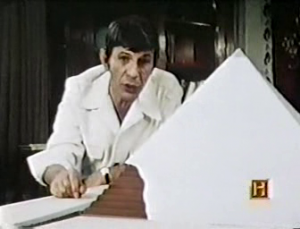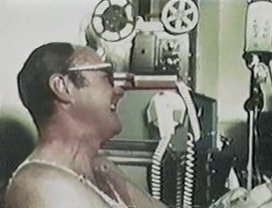In Search Of… S02E09 Pyramid Mysteries
Sand dunes and electronic music meant to sound like woodwinds. Nimoy says that ‘it seems impossible that an empty desert could hide one of the world’s greatest secrets.’
Does it? Honestly, ‘an empty desert’ sounds like a great place to hide literally anything.

We start looking at the Pyramids, from that very specific angle that filmmakers have to use to disguise the fact that they’re not in the ’empty desert’, they’re in the suburbs of Cairo. Nimoy wonders if the Pyramids are tombs, beacons for alien beings or energy generators. If they were tombs, he asks, why aren’t there mummies in them?
So… not going for the ‘tombs’ theory, Leonard?
Footage of temples and sarcophagi. Some stuff about Egyptian and forces that they believed controlled their lives… There’s not much point summarising this bit, it’s basically just mush. We’re talking about how the Egyptians wanted to defeat time and death. ‘Is it possible that they succeeded?’
Okay, kind of an unfocused opening. I suspect that this episode is going to be one of those ones that runs in a dozen directions at once rather than just stating a thesis.
Cairo! Nimoy talks it up as an intellectual centre, kind of crappy now but awesome in the past. Oh! And we see a shot of the Pyramids over some modern housing units. Honestly surprising to see.
Now closer footage of the Pyramids. Nimoy talks about the vast resources that went into making them, and says that the Egyptians must have had good reason for sacrificing so much.
Yeah… You see, that’s clearly true. We just have to accept that different peoples have different ideas of what a ‘good reason’ is. I personally think that burying monarchs is a lousy reason to build enormous structures. It doesn’t follow that everyone would feel as I do–least of all actual monarchs.
Nimoy is pointing at a model of the great Pyramid. He points out correctly that it was originally white (the limestone cladding was stolen at some point) and capped with some other material. Aside: Nimoy is wearing a white safari jacket. Did I mention that I love the guy? He talks about how awesome the Pyramid is. I guess he’s right. It is pretty awesome.
Shot of the sun over the Great Pyramid. Nimoy says that over the centuries there have been many theories about the Pyramids. For example it could be the remnant of an alien colonising force. Or a giant radio beacon. Or a collector of energy.
That ‘over the centuries’ line was kind of pointless. I’m willing to bet no one before the Twentieth Century thought any of those things.
Nimoy claims that the Pyramids are the most perplexing monuments in the world, though I think the Big Pineapple would like to differ. Shots of local farmers. Nimoy talks about the annual flooding of the Nile. The sheer vastness of the enterprise of building the Pyramids… ‘Unless they had another way.’
Oh boy.
Mayan Pyramids now. Looking at the Mayan Pyramids but ‘none have inspired the intense curiosity of the Pyramids of Egypt.’ Huh? Because the Egyptians perfected the ‘true Pyramid’.
I’m seriously having trouble following this. It’s not really anything. It’s just a bunch of stuff.
Looking at Zoser’s pyramid, the oldest known tomb Pyramid. Nimoy points out that this was a change from how things were done before. A little more on Pyramid building history: the second big pyramid collapsed while the third (the so called Bent Pyramid) was under construction. The builders quickly altered their plans, making this Pyramid smaller and with a shallower angle, hence the nickname. Later Pyramids were often built at the same angle as the top part of the Bent Pyramid. ‘Experiments continued for a thousand years,’ Nimoy says.
All of this seems completely consistent with the Pyramids being of terrestrial, human construction, built by people using trial and error.
Back with his model pyramid, Nimoy describes the theory that the Pyramids were built with the assistance of large, shallow earthern ramps. How long did it take? Nimoy quotes Herodotus’s figure of thirty years by 120 000 men. I don’t know if that’s true, but I know I have limited trust for Herodotus. Nimoy talks up the other achievements of Egyptian civilisation and points out they had no pulleys or block-and-tackle.
Lots of shots of what looks like restoration works at Abu Simnel, maybe? Nimoy points out that the Ancient Egyptians liked to build big things, which I can’t dispute. What secret does the Sphinx protect?
GET TO THE BLOODY POINT, SPOCK!
Now we’re talking about how the Great Pyramid was cracked open by treasure hunters, but found nothing inside but a maze of tunnels. Nimoy opens his model Pyramid and shows us the chambers inside. The cameras go into the ‘King’s Chamber’, where ‘no body has ever been found’.
Shafts from the kings chamber angle upwards to the sides of the Pyramid. I’m thinking ventilation, and Nimoy mentions the possibility. But, they could also be used to sight some planets from the chamber. Yes! Finally, some craziness!
Egyptians had a knowledge of astronomy. Pyramid sides were aligned to the cardinal points of the compass and the Pyramids tuned… to the stars.
And now we’re looking at San Francisco. We’re looking inside an occult shop and talking about ‘Pyramid power’. Good. My razor was getting a little blunt, thank you. But ‘others’ say that the history of the world is somehow encoded in the geometry of the Pyramid.
But before we can expand on this, we’re back to Egypt. Looking at the carvings on a temple wall. Nimoy stresses the Egyptian ideal of permanence – they were sure their established order was going to last forever, and yet it didn’t. I think I read a poem about that once. The Egyptians believed that they could live forever if their bodies were properly preserved. A brief description of mummification. Nimoy wonders whether Egyptian mummification was like modern cryogenics enthusiasts – they were waiting for people with advanced knowledge to revive them bodily.
Now a lab. Scientists are studying mummies to learn about the Ancient Egyptians. Brief precis of what they learned then back to Egypt. Noble Egyptians would be buried with a symbolic boat. Voyage across the Nile… Valley of the Kings… Howard Carter… Tutankhamun… Treasures from Tut’s tomb…
WHERE ARE YOU GOING WITH THIS?
Tutankhamun died after a brief reign, but Cheops lived for a long time. He must have had more treasure when he died. If he died. Workers sealed Cheops’ tomb from inside, but they probably didn’t die because they had a hidden exit. This exit might have allowed looters inside, but just as likely that Cheops’ secret is still inside.
Stanford now. Great. Lambert Dolphin, a geophysicist (and winner of the ‘Best Name Ever Medal’ in 1979) talks about the difference between the smooth exterior and rough interior stones argues against extra-terrestrial methods for Pyramid building. If they were cutting some rocks with lasers, he argues, why not all the rocks? Razor blades, fruit and flowers placed inside the real Pyramids rusted, wilted and were eaten, respectively. Since Pyramid power doesn’t work inside the real Pyramids, he doubts that model pyramids have much effect. He also denies Atlantis and UFOs, and argues in favour of a bunch of smart, hardworking people making things by the simple expedient of putting in a huge effort.
He’s being interviewed because he’s working on a method to find secret chambers in a non-destructive way. He thinks that there may be a previously undiscovered chamber, which Nimoy immediately assumes must be full of treasure.
Back to a Tutankhamen exhibition, then touring the USA. Nimoy wonders whether the popularity of this exhibition is evidence of a dissatisfaction with modernity — a theory so startlingly plausible that it literally makes me gasp.
Dr Dolphin talks about the importance of mysteries, and talks passionately about the unusual and the rare and the secret. It’s kind of stirring until he starts falling into clichés about the exotic East, but it’s fun for a while.
Final shot of the Pyramids. Nimoy wonders whether studying the Pyramid will ‘lead us to a greater wonder – the mind of man.’
This one was an odd one, even by In Search Of standards. Quite a lot of fairly real (if rather shallow) information about the Pyramids gets through. I suspect that the reason for this is that the Pyramids play a huge role in so many different esoteric theories that the writers and producers seem loath to pick one and run with it. Instead, UFO theories, mystic energy theories, pyramid power theories, pyramid prophecy theories are briefly introduced only to be forgotten. Since there aren’t any real alternatives to the ‘it’s a tomb’ theory built into mainstream archaeology, staid reality has a chance to shine — if only because its opponents are arguing among themselves.
Lacking an alternative, the episode accepts that the Pyramids are the work of human people and therefore studying them can tell us about human people. In spite of my frustrations with this episode, I honestly can’t fault its moral.
Best quote
Dr Dolphin: “There really is mystery all around us. I’m dedicated to the rediscovery of the mystery in life and to the unknown, to the unusual, to the rare.”
Summing up
Coherent direction: 5/10, Actual information: 6/10, Camerawork: 7/10, Nimoyness: 8/10, Leonard Nimoy’s model pyramid: 10/10. Total: 36/60. Credit



